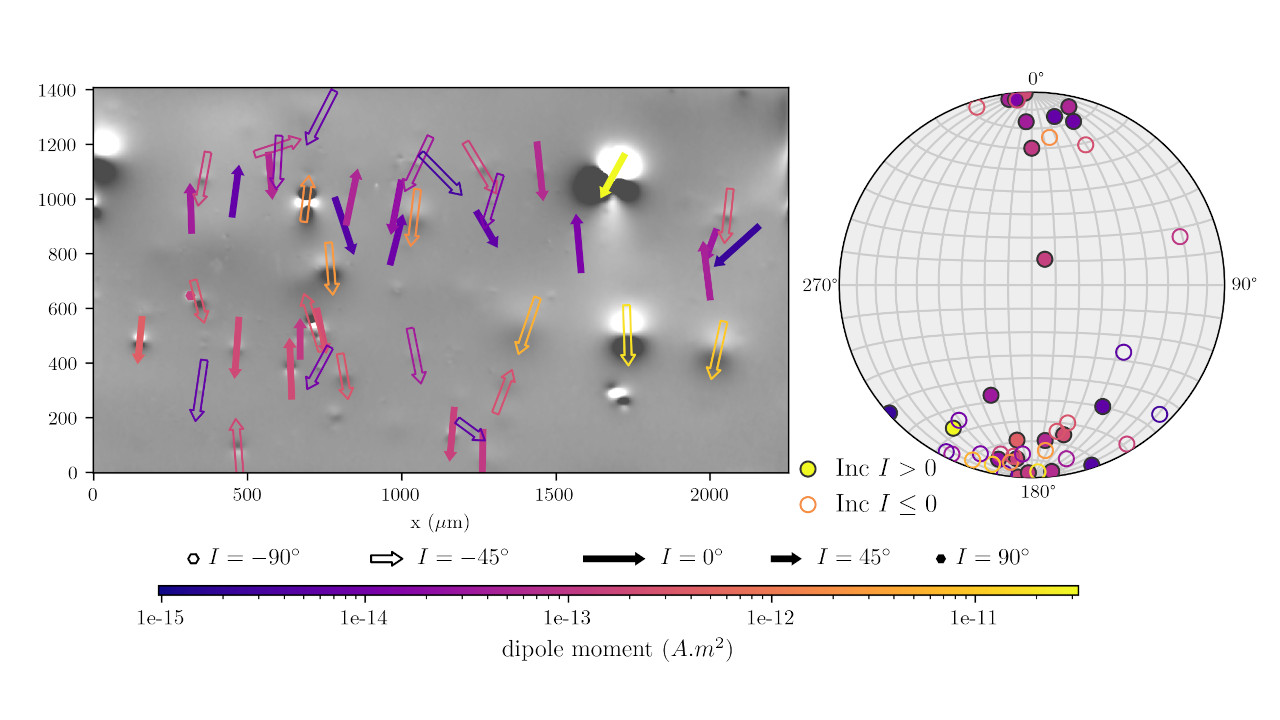New paper proposing a new cost-effective way to automatically analyze magnetic microscopy images
by Leonardo Uieda | 2024/08/07
After over 1 year in review (😮💨), we have a new open-access paper by lab member Gelson F. Souza Junior, the first of his PhD 🎉 :
Souza‐Junior, G. F., Uieda, L., Trindade, R. I. F., Carmo, J., & Fu, R. (2024). Full vector inversion of magnetic microscopy images using Euler deconvolution as prior information. Geochemistry, Geophysics, Geosystems, 25, e2023GC011082. doi:10.1029/2023GC011082
About
In short, very small magnetic particles in rocks and other materials can store information about what the Earth’s magnetic field was like in the past. But not all particles are good recorders of this magnetic information, and some may have recorded different overlapping directions and strengths. So it is important to measure each particle separately in order to identify and separate the good recorders from the bad ones. A device called a “quantum diamond microscope” is able to measure the magnetic field near the surface of a rock sample at microscopic scale. We propose a new method for processing data from this microscope that is able to find out the individual magnetizations of large amounts of small magnetic particles automatically. We created a computer program to execute the method, which calculates the 3D position and magnetization of each particle using the simple model of a magnetic dipole. We tested the method on simulated data, using fake magnetic particles for which we know the correct magnetization and position, and real data, both of which showed good results in most cases. The method we created has the potential to enable the widespread study of the magnetism of natural materials with more detail than before.
Here is an example of what the data and results we can obtain from it look like:

The main advantage of the method we came up with is that it can yield results for even small magnetic particles requiring only the data itself and a few seconds of processing times. Other techniques available usually required either manual picking of the signals in the images or expensive and time-consuming tomography data.
Open science
All of our results and the figures in the paper can be reproduced with the
material in the GitHub repository
compgeolab/micromag-euler-dipole.
It contains a REPRODUCING.md
file with instructions for setting up your computing environment and running
the code.
The repository is also archived on figshare
for long term availability and to provide a citation point.
The method is being implemented by MSc student Yago Moreira Castro into the open-source software project Magali, which is a part of Fatiando a Terra. Yago is also working with Gelson to make improvements to the method and implementing other quality-of-life features, such as plotting support and statistics of vectors and directions.

History
The idea for this paper came from a chat I had with Prof. Ricardo Trindade at AGU 2019, where he presented the problem and I realised it was very similar to things I had worked on before in the PINGA lab (Melo et al. (2013) and Oliveira Jr. et al. (2015)). We started planning a collaboration to combine the CompGeoLab’s expertise in applied geophysics and USPMag’s long track record in paleomagnetism.
The manuscript was originally published as a preprint n June 2023 and took much to long in the peer-review process. But we’re very happy that it’s finally out because Gelson is already working on many improvements to the method!
Leo
This research is being developed under our Royal Society grant and Gelson’s PhD, which is funded by FAPESP.
The plain language description of the paper was originally published in the paper and preprint, both licensed CC-BY.
